
ALTHOUGH he is a ubiquitous figure from mid-November through December 26th, little is known of the daily existence of Santa Claus, who brings toys to good little boys and girls every Christmas Eve by somehow dragging his bulk, accompanied by sacks full of trinkets, down chimneys, even in homes that have no chimneys. We do know that his mode of transport will please environmentalists as no oil had to be fracked out of the earth’s mantle to power his chosen mode of transport; instead, he employs eight, sometimes nine, reindeer, beasts found in northern Scandinavia. Our knowledge of Claus comes mainly from the art of Thomas Nast, the poetry of Clement Clark Moore, and the music of singing cowboy Gene Autry. But what is Claus’ story? How was he appointed this role? Who owns his factory, purported by legend to be north of the Arctic Circle? How is it funded? We are awaiting a Spielberg or a Disney Corporation to give the full measure of biographical splendor to this figure.
The legends, of course, abound. Somehow, a 4th-Century Greek bishop, Saint Nicholas of Myra, acquired the reputation of generosity that continued over the centuries until the Dutch built a further legend about him and contracted his name to “Sinterklaas,” and the British further adjusted this name and spelling to English pronunciation. The tradition spread to the States, and the three mages mentioned above crystallized the legend. However, many think that Claus walks the earth still; in the 1880s, Virginia O’Hanlon knew it and NY Sun editor Francis Church confirmed it. Claus, however, has remained totally resistant to modern media as the centuries have passed. He has never appeared in the pages of Vanity Fair, or on the sets of Kimmel, or on the internet domains of Facebook or Twitter. For Claus, mystery is his greatest advantage, and it is mysterious he will remain.
While Claus has repeatedly been purported to have been seen coming “right down Santa Claus Lane,” no street of that name exists within the five boroughs of New York City. However there are a scattering of streets around town that remind one of Christmas, the anniversary of Jesus Christ’s birth that inspired Claus’ generosity.
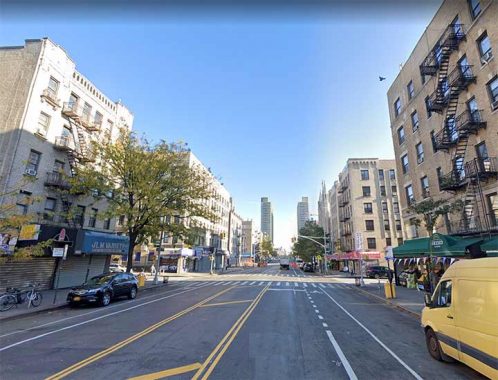
St. Nicholas Avenue, Manhattan
Saint Nicholas, despite his Greek origins, is especially revered in northern Europe. He was the patron saint of New Amsterdam, the colony established by the Dutch in the 1620s, and the name of the first church established in the colony. St. Nicholas Avenue, which zigs and zags around northern Manhattan from Central Park to Inwood, partially overlays an older road that was once a Native American trail but was later employed by colonists and named Kingsbridge Road as it led to the toll bridge spanning Spuyten Duyvil and now is honored by innumerable Bronx neighborhoods. The routes of St. Nicholas Avenue and West 125th Street were also laid out in addition to the preexisting older road, which became “St. Nicholas Avenue” in 1901 in the same spate of renaming that produced Columbus, Amsterdam and West End Avenues, which had previously been 9th, 10th and 11th Avenues.
There are two other streets named for St. Nicholas in Manhattan: St. Nicholas Terrace, which runs along the west side of St. Nicholas Park, and St. Nicholas Place, way uptown at West 155th near where the Polo Grounds had been.
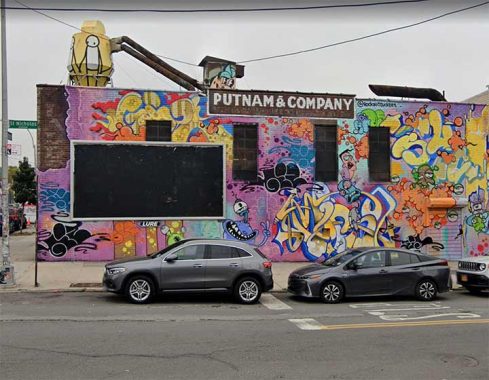
St. Nicholas Avenue, Brooklyn
There is a loose, and I mean loose, logic to the naming of the north-south avenues in Bushwick and Ridgewood that hark back to the Dutch colonial era. There’s St. Nicholas Avenue as well as Knickerbocker and Onderdonk Avenues (I’ve always said that old Dutch names are fun to say) as well as Irving Avenue, which came along later on; it was named for Washington Irving, who wrote about Ichabod Crane and Rip Van Winkle, figures in Dutch Colonial New Amsterdam: originally Hamburg Avenue, it was renamed because of anti-German sentiment during World War I.
Here, we see some of the “street art” that appears on the rubric “Bushwick Collective” that centers around the junction of St. Nicholas Avenue and Troutman Street. In this case, the spray can Van Goghs have actually repainted the name of a previous business, Putnam & Company, though the copy beneath the first line has been allowed to continue to fade.
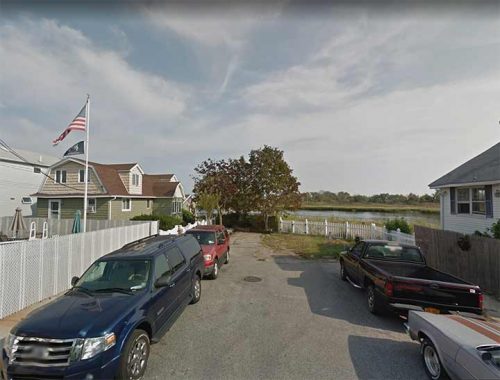
Noel Avenue, Brooklyn
The word “noel” is derived from the French word for “birth,” ultimately from the Latin; English employs the root in the words “native” and even “natural.” It has over the centuries been employed to mean Christmas carols and by extrapolation, the holiday itself. Oddly, the word is two syllables in this context, and as a man’s name, just one. The feminine form keeps the two syllables.
In Brooklyn, Noel Avenue is way down there: it’s in the south end of Gerritsen Beach, the insular neighborhood tucked between Marine Park and Shell Bank Creek, the waterline pictured here. Here, Noel Avenue interrupts a set of streets named in alphabetical order, from Abbey Court, Beacon Court, through the M street, Madoc Avenue. Noel Avenue appears between the F and G courts, Frank and Gain. Gerritsen Beach is neatly divided into two halves by a creek inlet, with only Gerritsen Avenue connecting them.
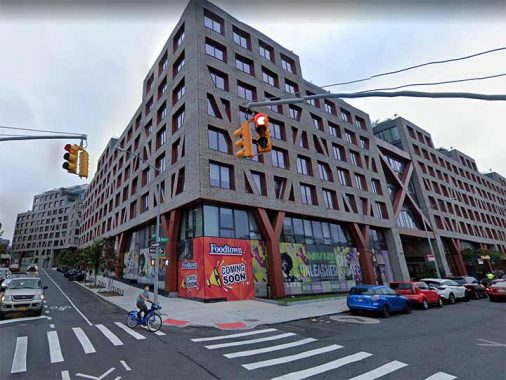
Noll Street, Brooklyn
Back up north we go, this time to northern Bushwick, in a warren of streets south of Flushing Avenue and east of Bushwick Avenue in the heart of Brooklyn’s old Brewery District. The gargantuan Denizen Bushwick houses, seen here, sit on the former plot of the Rheingold Brewery. The now-defunct brand sponsored Mets games in the 1960s and 1970s.
I’m going to have to get a little creative with spellings, forgive me.
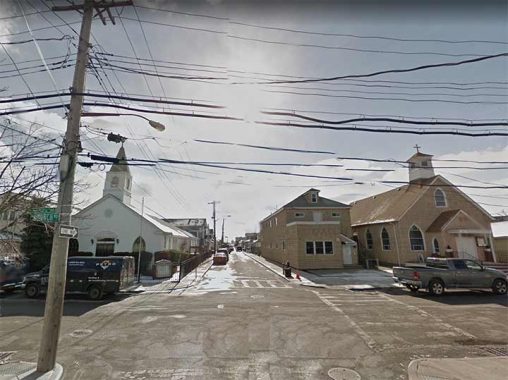
Noel Road, Queens
Broad Channel’s only two churches, St. Virgilius Roman Catholic and Christ Presbyterian are only a half block away from each other on Noel Road and Church Road (the latter is probably named for the Presbyterian church). The Catholic church and school are refreshingly modest buildings dating to 1924. The St. Virgilius convent, which appears similar to a regular residential building save for the presence of a cross above the front door, is a few blocks away at Noel and Lanark Roads. St. Virgilius merged with St. Camillus on the peninsula in 2008; when Christ Presbyterian was damaged by fire and storms, St. Virgilius welcomed its congregation.
The positioning of Noel Road is unusual, as it’s the only named east-west road in Broad Channel. The island has its own street numbering system independent from the rest of Queens (as does the Rockaway peninsula) with East and West roads from 1 through 22, divided into east and west sectors by Cross Bay Boulevard. However Noel Road runs east and west between 7th and 8th (see the Google map). How did this come about? well, that’s another mystery.
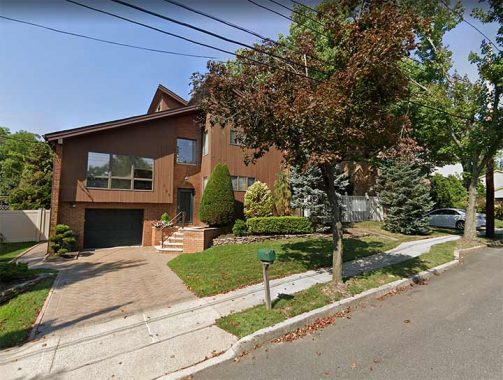
Noel Street, Staten Island
Noel Street runs for a few blocks in southeast Staten Island in Eltingville and Woods of Arden north of Hylan Boulevard and close to several protected nature parks including Blue Heron and Arbutus Woods. Also nearby is the historic Frederick Law Olmsted House, which is currently under renovation into a public space.
This is a very pleasant residential area with some new housing like that shown here.
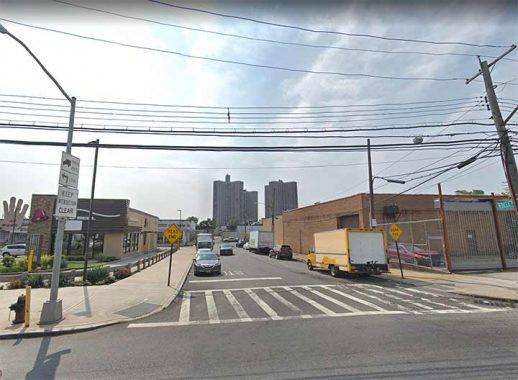
Noell Avenue, Bronx
The Bronx entry in the Christmas streets category (and with that spelling, it’s stretching it) is dead-end Noell Avenue, found on Tillotson Avenue just west of the super-busy Conner Street on the edge of Co-Op City. The dead end borders a c ar wash attracting motorists with a giant hand and a warehouse.
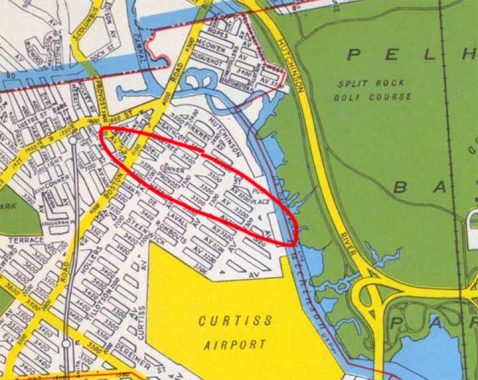
The city once had bigger plans for Noell Avenue, running it in 1949 through what became Freedomland and is now Co-Op City but was then planned for the never-built Curtiss Airport.
As always, “comment…as you see fit.” I earn a small payment when you click on any ad on the site.
12/25/21

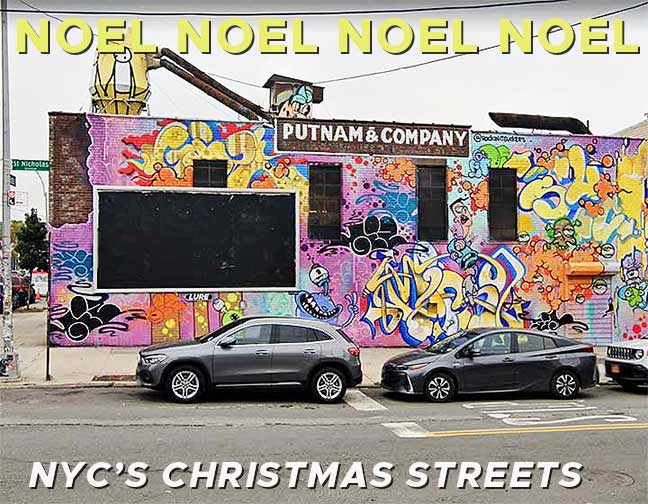
5 comments
Thanks for this wonderful article, Kevin! Your website is a gift to many of us, 365 days a year. With best wishes for a Merry Christmas and a healthy and happier New Year, from Renée in Tucson (former Staten Islander)
Brooklyn’s St. Nicholas Avenue (briefly shared with Queens) may have been, along with Wyckoff Avenue, named for local landowner Nicholas N. Wyckoff. Both of these streets date to about 1855 (when Williamsburg and Bushwick were annexed to the City of Brooklyn) and were laid in out in part through Nicholas Wyckoff’s farm. This may have been a pun on the part of municipal planners (or Wyckoff himself), or it may simply stem from the Dutch cultural devotion to St. Nicholas in pre-German Bushwick. Note that this appears to predate Manhattan’s St. Nicholas Avenue; according to Henry Moscow (The Street Book) that did not receive its name until 1901.
Now as to the “non-Christmas” Wilson Avenue. It was originally (1855) Johnson Avenue. At that time there were two Johnson Streets, one Downtown and one in Williamsburg, with Johnson Avenue planned through Bushwick. The two Johnson Streets were initially differentiated as being in the Western or Eastern District. By 1869 this was beginning to become unworkable, and with Bushwick developing and addresses appearing on Johnson Avenue something needed to be done to simplify matters. In 1869 the City of Brooklyn renamed a large number of streets to minimize duplication. So, Johnson Street downtown stayed, Johnson Street Williamsburg became Johnson Avenue and Johnson Avenue Bushwick became Hamburg Avenue in reference to the area’s growing German population. Circa 1919 it was renamed for President Woodrow Wilson.
You can call me Ray and you can call me Jay, but ya doesn’t have to call me Johnson!
There’s a Jefferson Street and Avenue in Bushwick about one mile apart.
When the great Willie Mays first joined the New York Giants in 1951 as a raw, 20 year old rookie prodigy, the Giants arranged for him to live in an apartment on St. Nicholas Place just south of his home ballpark. He rented a room from an older lady, who cooked his meals, and he played stickball with the neighborhood kids. The arrangement kept the young Willie Mays away from pursuits more tempting than stickball. Imagine a ballplayer doing that today, especially one with the skills that Mays exhibited even before the Giants brought him up from the minor leagues. One reason for Mays’s long Hall of Fame career was the self-control he learned early on, possibly from playing stickball on St. Nicholas Place.
In the ’40s my great uncle Joe “Doc” Wisan used to joke “what Christmas song applies to Columbus Avenue? No-el, no-el.”